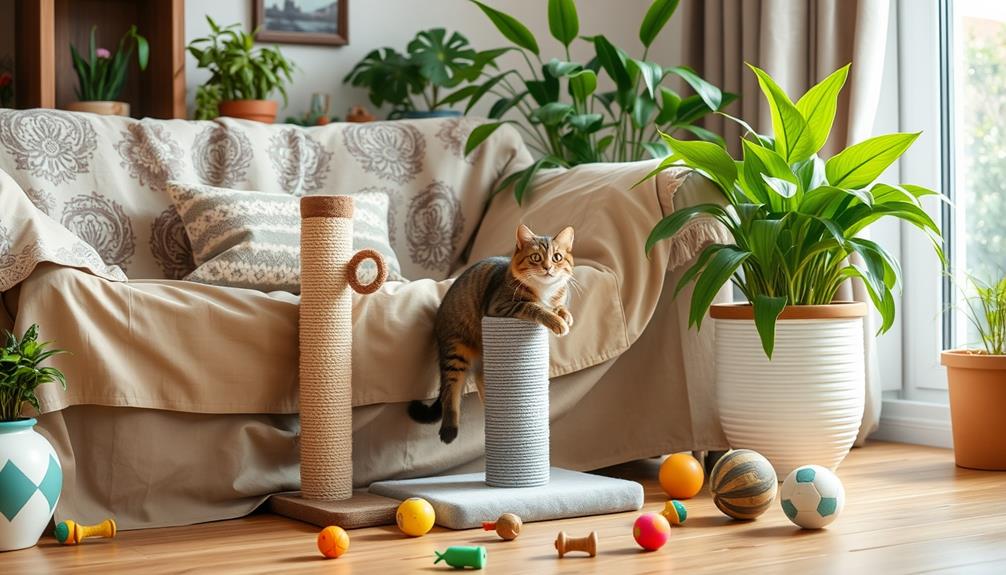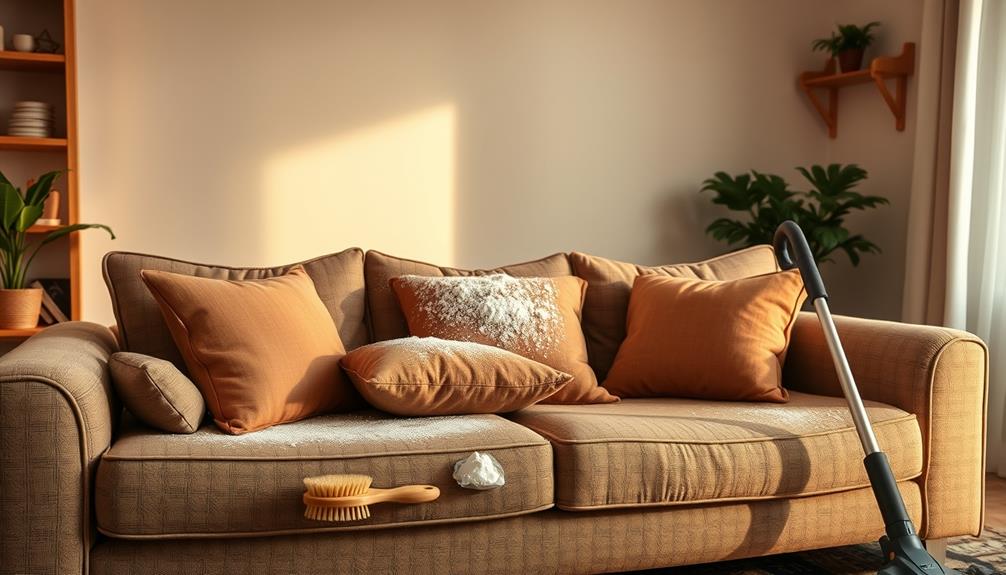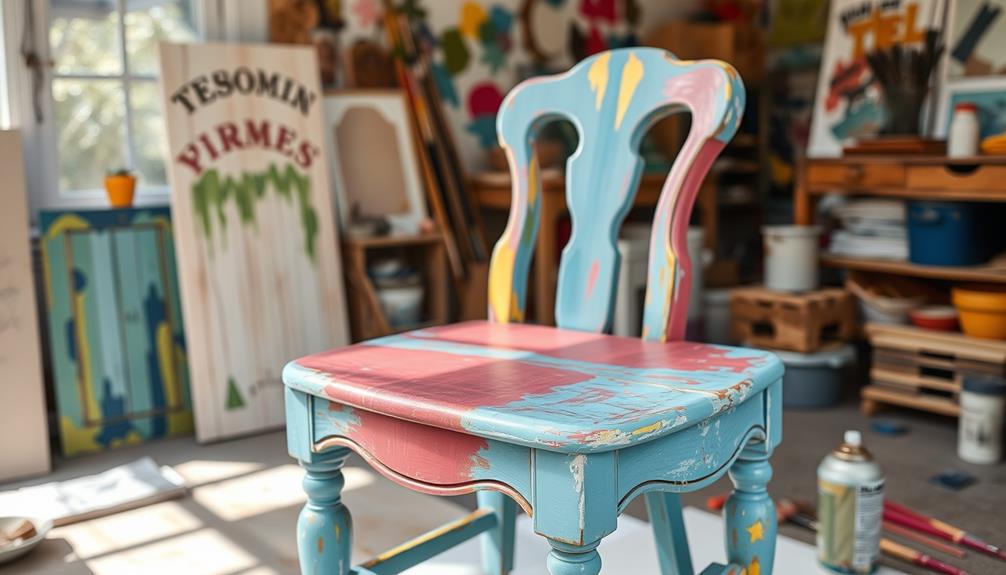To prevent your cat from scratching furniture, it’s important to understand their natural instinct to scratch for nail maintenance and marking territory. Offer a range of scratching posts and pads made from different materials like sisal and cardboard, positioning them near where your cat likes to rest. Use positive reinforcement to guide your cat towards these alternatives, rewarding them when they use them appropriately. You can also make your furniture less appealing by using double-sided tape or protective covers. Regularly trimming your cat’s claws can also help reduce damage. If you’re looking for more effective strategies, continue to explore different options. Consider seeking advice from a professional behaviorist or veterinarian to help manage your cat’s scratching behavior. If your cat accidentally left pen marks on your leather furniture, you can use a leather cleaner and conditioner designed specifically for removing pen marks from leather. Home remedies like rubbing alcohol or nail polish remover may also be effective at removing pen marks from leather surfaces.
Key Takeaways
- Provide a variety of scratching posts and pads to satisfy individual cat preferences and encourage appropriate scratching behavior.
- Use positive reinforcement, such as treats or praise, to reward cats for using designated scratching surfaces.
- Implement gentle deterrents like double-sided tape or cat-safe sprays on furniture to discourage scratching.
- Regularly trim your cat's claws to minimize damage to furniture while maintaining their natural scratching instincts.
- Create an engaging environment with toys and interactive play to reduce boredom and anxiety, which can lead to scratching.
Understanding Scratching Behavior
When it comes to understanding scratching behavior, it's essential to recognize that cats scratch for various instinctual reasons. Cat scratching serves multiple purposes, including nail maintenance, muscle stretching, and territory marking.
This instinctual behavior starts as early as 8 weeks old, as your cat uses its claws to visually and chemically mark its territory through scent glands in its paws. Additionally, providing proper outlets for scratching can help maintain your cat's physical and mental health, similar to how ultimate hamster care guides emphasize the importance of enrichment for pet well-being.
Understanding scratching helps you appreciate that it's not just a nuisance but a natural outlet for your cat. Most cats prefer vertical scratching surfaces, though individual preferences can vary. This means your cat might choose to scratch your furniture over a designated scratching post if it doesn't meet their needs.
Moreover, scratching behavior helps relieve anxiety and tension, contributing to your cat's overall well-being. By understanding scratching, you can develop effective strategies to minimize furniture scratching while still satisfying your cat's natural instincts.
Recognizing these motivations allows you to create a more harmonious living environment, ensuring both you and your feline friend can coexist happily without sacrificing your furniture.
Providing Appropriate Alternatives
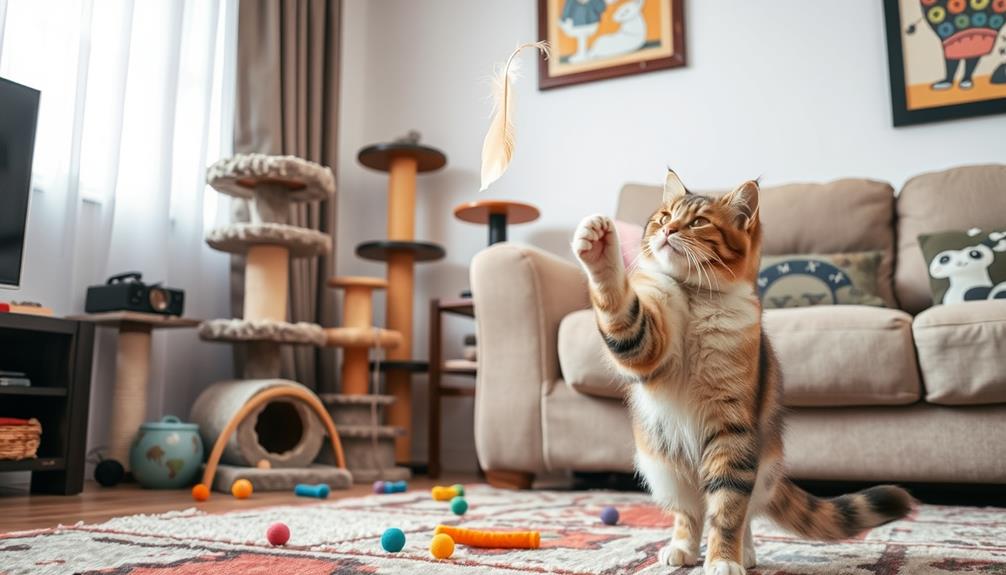
To keep your furniture safe, providing appropriate scratching alternatives is key.
Consider the unique grooming needs of your cats, much like the special skin care routines required for hairless breeds.
Invest in tall scratching posts and effective pads that cater to your cat's preferences.
Don't forget to sprinkle some catnip around these options to make them more enticing!
Recommended Scratching Posts
For cat owners looking to protect their furniture, investing in the right scratching posts is essential. A good scratching post should be tall and sturdy, ideally around 28-36 inches, to accommodate your cat's natural scratching behaviors. Different materials like sisal, carpet, or wood cater to what your cat prefers, encouraging frequent use.
Here's a quick overview of recommended scratching post types:
| Type of Scratching Post | Features |
|---|---|
| Vertical Scratching Post | Tall, with a sturdy base |
| Horizontal Scratching Post | Ideal for lounging and scratching |
| Cat Trees | Multi-level, combines play and scratch |
| Sisal Wrapped Post | Durable, appeals to natural instincts |
| Carpeted Post | Soft, comfortable for clawing |
Positioning scratching posts near furniture that your cat usually scratches can help redirect those behaviors. Offering a variety of scratching posts, including both vertical and horizontal options, can satisfy diverse preferences, especially in multi-cat homes. Regularly introducing new posts or rotating existing ones keeps your cat engaged and prevents boredom, ensuring they stick to their designated scratching spots.
Effective Scratching Pads
While scratching posts are a great start for protecting your furniture, incorporating effective scratching pads can offer cats even more options to satisfy their natural instincts. Scratching pads come in various textures, like cardboard, sisal, and carpet, catering to what cats prefer. This variety encourages your cat to engage with the pads rather than your furniture.
Additionally, just as toddlers benefit from best educational construction toys for toddlers to promote their fine motor skills, cats can also enjoy the tactile stimulation provided by different scratching surfaces.
To maximize usage, position scratching pads in high-traffic areas near the furniture that your cat frequently targets. This placement makes it easier for them to choose the pads over your sofa. Offering both vertical and horizontal scratching pads accommodates individual preferences, enhancing satisfaction and preventing damage to your belongings.
Don't forget to rotate the scratching pads or introduce new ones regularly to keep your cat interested. You can also sprinkle some catnip on the pads or place treats nearby to motivate your cat further.
This reinforcement helps establish a positive connection with the scratching pads, steering them away from your furniture. By providing these effective alternatives, you're not only protecting your possessions but also promoting a happy, healthy scratching behavior that your cat will appreciate.
Use of Catnip
Catnip serves as a powerful tool for redirecting your cat's scratching behavior towards designated scratching posts or pads. By using catnip, you can encourage your feline friend to engage with these appropriate surfaces instead of your furniture.
Cats are naturally drawn to catnip, which stimulates their instincts to scratch and play, making it an effective way to promote healthy habits.
To enhance the appeal of new scratching posts, sprinkle dried catnip on them. This simple step can greatly increase usage, helping to successfully redirect their scratching behavior.
Additionally, consider incorporating interactive cat toys infused with catnip. These toys not only entertain your cat but also provide an outlet for their scratching urges.
Don't forget the power of positive reinforcement! Whenever your cat uses the scratching post, reward them with treats or praise. This association strengthens their preference for scratching the designated area, reinforcing the behavior you want to promote.
Training Techniques for Cats
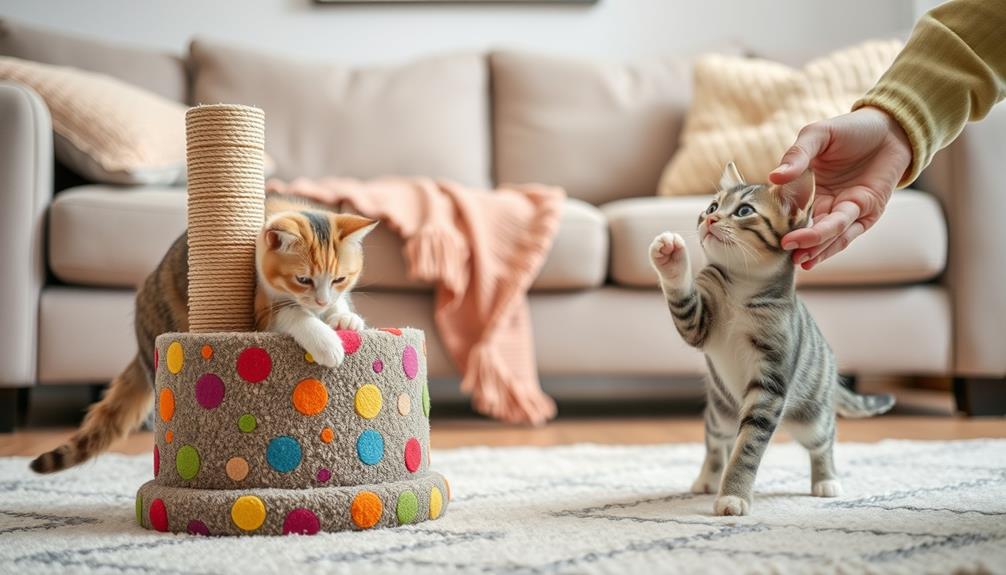
To effectively train your cat away from scratching furniture, you'll want to use positive reinforcement techniques and redirection methods.
Placing scratching posts in strategic locations can also encourage your cat to use them instead of your couch.
With a little patience and consistency, you can help your feline friend learn the right behaviors.
Positive Reinforcement Techniques
Positive reinforcement techniques are one of the most effective ways to train your cat to use a scratching post instead of your furniture. When your cat scratches the furniture, immediately redirect your cat's attention to the scratching post. As soon as they engage with it, reward your cat with high-value treats or praise. This helps them associate the scratching post with positive experiences.
To enhance your training, consider the following table:
| Step | Action | Reward Type |
|---|---|---|
| 1. Observe | Watch for furniture scratching | None |
| 2. Redirect | Direct to scratching post | High-value treats |
| 3. Praise | Verbally encourage them | Verbal praise |
| 4. Reward | Give treat after scratching post | High-value treats |
| 5. Maintain | Be consistent with family | All types of rewards |
Using high-value treats, like small pieces of cooked chicken, can motivate your cat to choose the scratching post. Remember, consistency is key; involve everyone in your home to solidify the desired behavior and guarantee your cat understands where it's acceptable to scratch.
Effective Redirection Methods
Redirecting your cat's scratching habits requires a thoughtful approach that engages their instincts. Start by providing a variety of scratching posts and pads made from different materials, placing them near the furniture your cat tends to scratch. When your cat uses these designated areas, use positive reinforcement like treats or praise to reinforce this desired behavior.
If you catch your cat scratching furniture, don't panic. Instead, gently redirect your cat's attention to the scratching post or pad. Use toys or catnip to encourage them to explore these alternatives.
If they continue to scratch furniture, consider using gentle deterrents, such as double-sided tape, on those surfaces. This makes scratching less appealing and nudges them toward their scratching posts.
Regularly trimming your cat's claws can also minimize damage and reduce the likelihood of them scratching furniture.
The key to success is consistency and patience—train your cat by ensuring they always have appropriate surfaces to scratch. With time and effort, you'll help your cat to use their scratching posts effectively instead of your furniture.
Scratching Post Placement Strategies
When it comes to keeping your furniture scratch-free, strategically placing scratching posts can make all the difference. Start by placing the scratching post near the furniture your cat frequently targets. This encourages them to redirect their behavior to the designated area. Consider positioning multiple scratching posts in high-traffic spots or near their favorite resting places to boost visibility and accessibility.
Ensure that your scratching posts are tall and sturdy, allowing your cat to stretch fully. Cats prefer vertical surfaces, so this is essential for their comfort. Additionally, experiment with different materials for scratching posts, such as sisal or wood, to find what your cat likes best.
Regularly encourage your cat to scratch the posts by rewarding them with treats or praise, which helps in reinforcing the positive behavior.
Here's a quick reference table to help you with placement strategies:
| Placement | Purpose |
|---|---|
| Near furniture | Redirect scratching behavior |
| High-traffic areas | Increase visibility and accessibility |
| Favorite resting spots | Encourage frequent use |
| Sturdy and tall posts | Allow full stretching and comfort |
Making Furniture Less Inviting
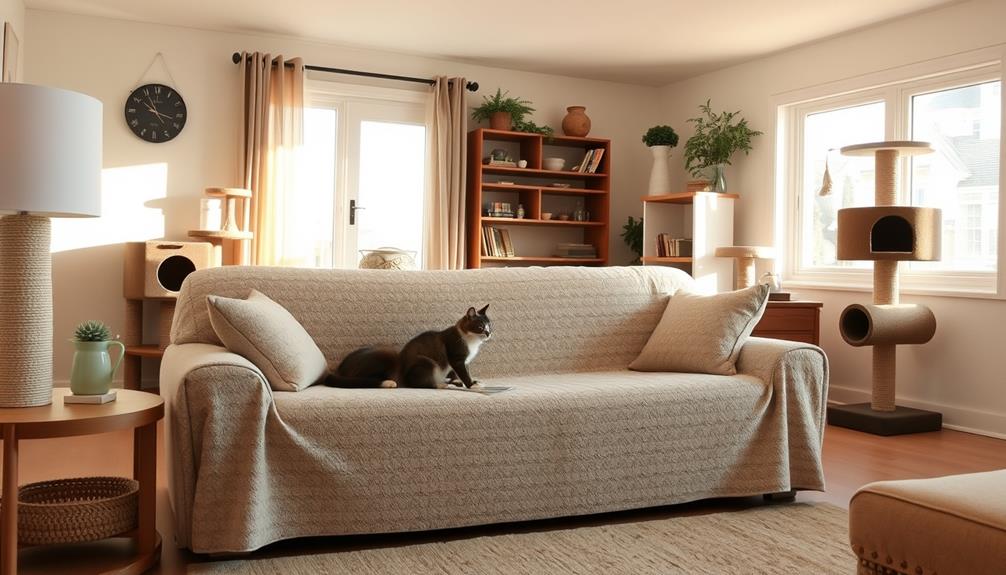
To deter your cat from scratching furniture, it's vital to make those surfaces less inviting. Start by applying double-sided sticky tape or clear packing tape to targeted areas. Cats typically dislike the sticky texture, which can discourage their scratching behavior.
You can also use protective covers, like sheets or vinyl furniture shields, to create a barrier that keeps your cat from accessing the surfaces they love to scratch.
Consider using cat-safe deterrent sprays with unpleasant scents, such as citrus or vinegar, to make furniture less appealing. These scents can greatly reduce your cat's desire to scratch.
Additionally, it's important to clean and deodorize furniture regularly. Removing any scent markings will help eliminate the familiarity that invites scratching.
Lastly, drape blankets or throw covers over your furniture. This not only protects your surfaces from scratch marks but can also enhance your room's decor.
Managing Anxiety in Cats
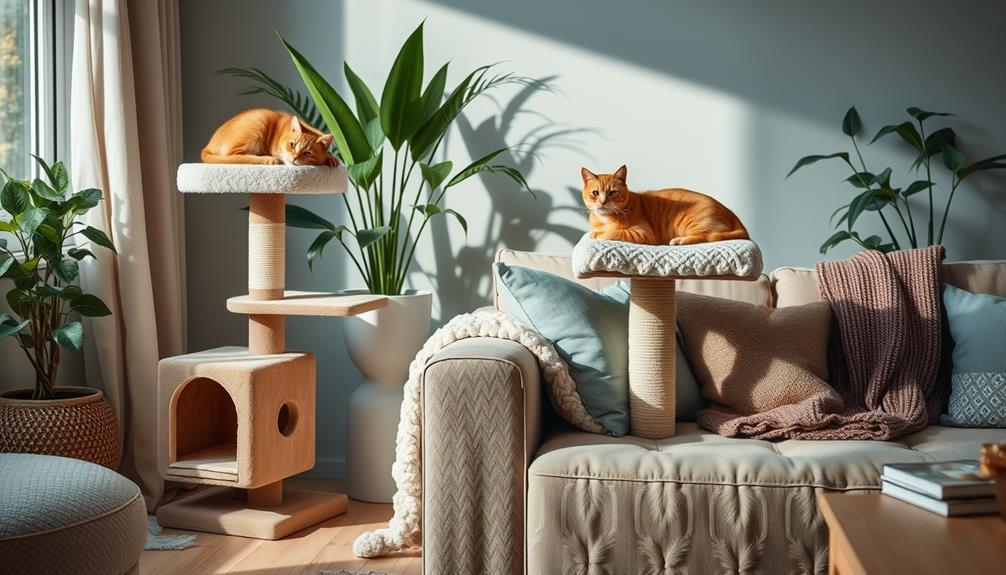
Understanding that anxiety can drive your cat to scratch furniture is crucial for effective management. Identifying the underlying anxiety is the first step.
Consider using calming sprays or supplements to help ease your cat's stress levels. Additionally, engaging in interactive play is essential. Regular playtime not only strengthens your bond but also provides mental stimulation, reducing anxiety.
Create a safe space for your cat, filled with familiar scents and toys. This quiet area can help your cat feel secure and less inclined to exhibit scratching behavior.
Incorporate enrichment activities like cat trees or window perches, allowing your cat to explore and engage with their environment. Outdoor options, like a catio or leash walking, can also greatly lower stress.
If your cat continues to struggle with anxiety, consulting a Certified Applied Animal Behaviorist can provide tailored strategies. They can help you understand your cat's specific needs and develop a plan to address anxiety-related scratching behaviors effectively.
Avoiding Harmful Practices
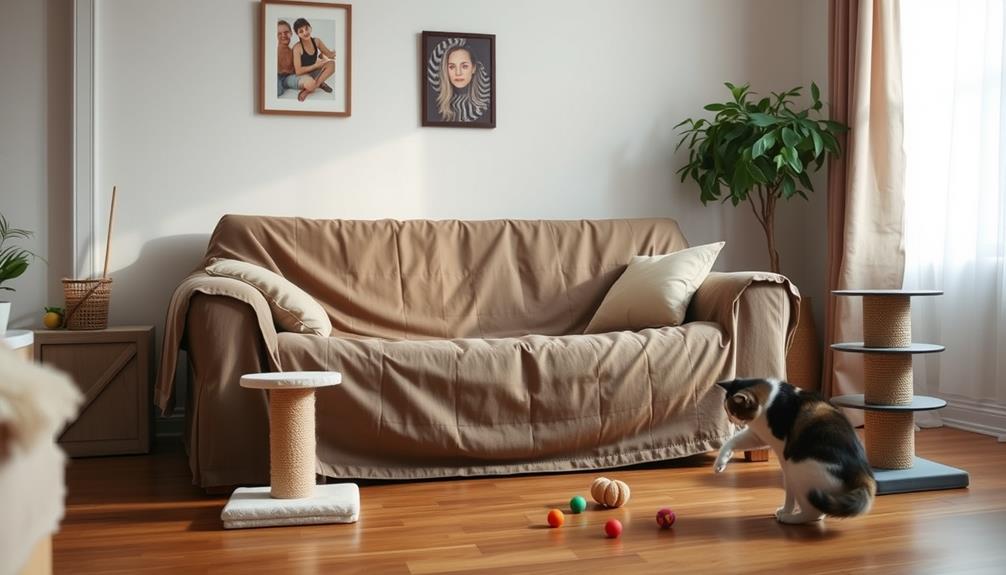
Cats have a natural instinct to scratch, and managing this behavior effectively means avoiding harmful practices that can do more harm than good.
One of the most detrimental actions you can take is to punish your cat for scratching. Yelling or physical reprimands can create anxiety and lead to fear-based aggression, making the problem worse.
Declawing is another harmful practice often mistakenly viewed as a solution. This painful procedure removes not only the claws but also the toe bones, and it's banned in many places for ethical reasons.
Instead of resorting to these harmful methods, focus on positive reinforcement. Reward your cat when it uses a designated scratching post, and you'll find that it's much more effective in modifying scratching behavior.
Additionally, consider using gentle deterrents, like motion-detection air sprays, to redirect their attention without causing fear or harm.
Remember, scratching is a natural part of cat behavior, so it's essential to provide appropriate outlets for this instinct.
Recommended Products for Protection
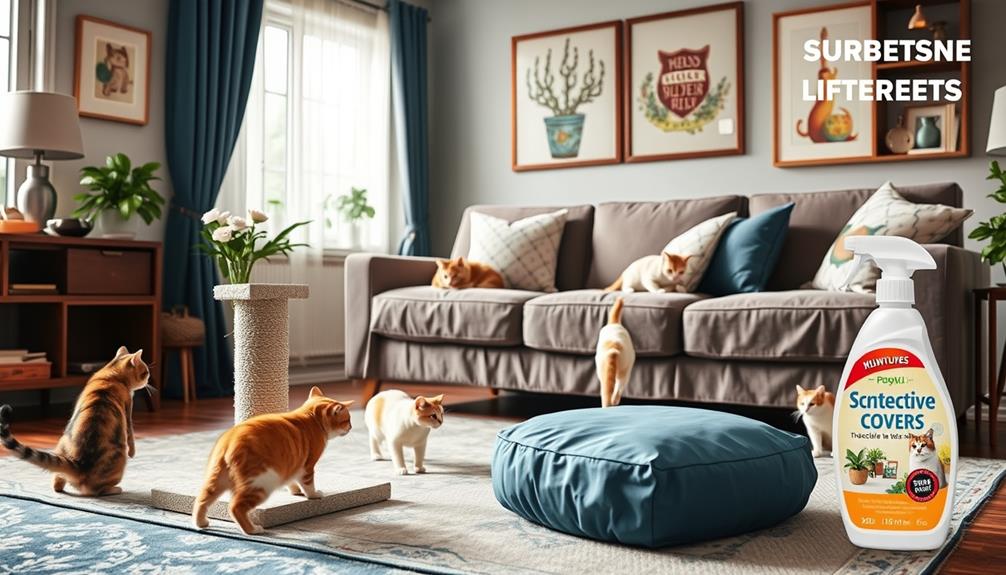
Protecting your furniture from cat scratches doesn't have to be an intimidating task. Start with Clawguard Furniture Shields, which are transparent and flexible. They blend seamlessly with your decor and protect your furniture from scratches while being easy to install with twist pins.
If you want to deter your cat from scratching, consider Pioneer Pet Sticky Paws. This double-sided tape adheres to surfaces, effectively stopping your cat from scratching without leaving any residue behind.
Another great option is Soft Claws Nail Caps. These come in various colors and cover your cat's sharp claws, providing a non-invasive way to protect your furniture. Just remember to replace them every 4-6 weeks.
For a more proactive approach, try the On2Pets Skyline Scratching Post. With multiple sisal-covered posts of varying heights, it encourages your cat to scratch vertically while supporting up to 32 pounds for durability.
Finally, the Our Pets Double-Wide Scratching Pad offers a comfortable surface for both vertical and horizontal scratching, making it perfect for even the timid cats.
Invest in these products to effectively stop your cat from scratching the furniture and keep your home looking great.
Resources for Further Support

When it comes to managing your cat's scratching behavior, there are numerous resources available to help you. You can take advantage of free video consultations with veterinary professionals, which offer personalized advice that deepens your understanding of scratching behaviors and effective solutions.
Additionally, access a variety of cat care articles that provide strategies for handling not just scratching, but other common feline issues as well.
Don't forget to subscribe to newsletters from veterinarians to receive ongoing tips on maintaining your cat's health and well-being, including insights on scratching problems. Engaging with community resources or local animal behaviorists can also provide tailored advice and support specifically focused on addressing scratching behaviors in cats.
If you need immediate assistance, consider utilizing telehealth services for instant veterinary guidance on behavioral issues, including scratching. This way, you guarantee that you receive timely and relevant support, helping you create a more harmonious environment for both you and your furry friend.
With these resources at your disposal, you're well-equipped to tackle your cat's scratching challenges effectively.
Frequently Asked Questions
What Deters Cats From Scratching Furniture?
To deter cats from scratching furniture, try applying double-sided tape, using textured mats, or spraying cat-safe scents. Providing appealing alternatives like scratching boards can redirect their behavior and keep your furniture safe.
How Do I Stop My Cat From Scratching My Couch?
Your couch is a canvas, and your cat's scratching is their art. To stop this, provide sturdy scratching posts, use sticky tape, apply pheromones, and cover vulnerable areas. Regularly trim nails to minimize damage.
What Scent Will Keep Cats From Scratching?
To keep cats from scratching, consider using citrus scents like lemon or orange. Cats typically dislike these odors, so applying them around areas they frequent can help deter unwanted scratching behavior effectively.
Can You Train a Cat to Not Scratch Furniture?
Yes, you can train a cat not to scratch furniture. By providing alternatives, using positive reinforcement, and redirecting their behavior, you'll encourage your cat to use designated scratching areas instead of your furniture.
Conclusion
Just like a gardener nurtures their plants to flourish, you can cultivate a harmonious home by guiding your cat's natural instincts. By providing scratching posts and using gentle training, you'll transform your furniture into a serene sanctuary rather than a battlefield. With the right tools, you'll see your cat happily honing their claws on the alternatives you've set up, allowing both of you to enjoy a peaceful coexistence in your shared haven.
